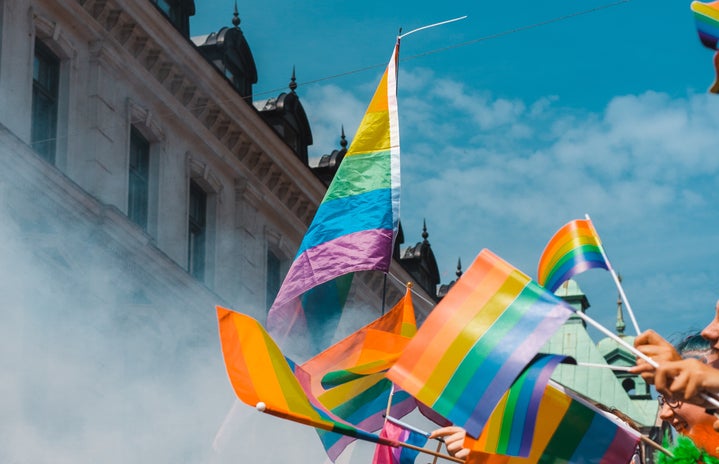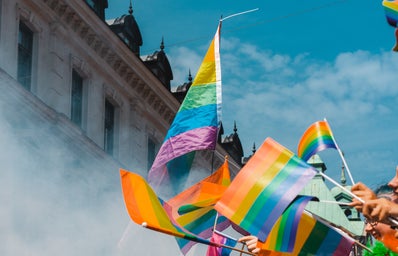I recently finished FX’s hit series, Pose, and my life has truly changed for the better. Pose explores the lives of queer people living in Harlem, NY in the late 1980s. At this time, ballroom culture in Harlem was flourishing; a beautiful sub-culture of the LGBTQ+ community created by black and Latinx folks. Ballrooms have existed for over a century and have an incredibly rich history, but in a nutshell, ballrooms were a place for queer people of color to gather and compete in various categories, such as runway, face, body, vogue performance, beauty, and more.
Ballroom vogue is a style of dance that emerged from these ballroom categories, with “Femme Queen Vogue” and “Butch Queen Vogue” being iconic categories seen throughout the series. Vogue performance in the ballrooms inspired Madonna’s iconic hit in 1990, “Vogue,” which was a quintessential contribution to amplifying the voices of those participating in ballrooms at this time. “Vogue” led vogue dancing to mainstream pop culture, with the catchy chorus singing, “Vogue to the music.” Pose dives deeper into the significance of Madonna’s allyship and amplification of queer culture at this time. Madonna remains an iconic queer icon today, and has stood with the queer community even when it wasn’t the “cool” thing to do; from writing “Vogue” to advocating for those with AIDS. Vogue performance is still hugely popular in today’s queer culture. Popular moves you may recognize are the iconic duck walk or dip (it’s important to note that the dip is commonly misnamed as a “death drop” in today’s pop culture). Vogue dance performance has an energy that’s unmatched; it’s sassy, joyous, empowering, and the most entertaining thing to watch. The vogue dancing in this series alone is reason enough to check it out.
Pose taught me the significance and beauty of chosen families, and how sometimes, those bonds can be stronger than blood. An essential part of ballroom culture is the houses. Those who belonged to houses were typically the participants in the balls, and houses would compete against each other to see who could win the most categories. In Pose, the houses live together, and each house has a mother that takes care of them. Blanca, the mother of the House of Evangelista, refers to the members of her house as children, as they don’t have blood-parents to support them. Throughout the series, Blanca takes care of all of her children, lifting them out of hard times and encouraging them to reach their fullest potential. Houses usually consisted of those outcast by their families for being queer, and Pose does a phenomenal job showing how houses save lives. Many characters would be homeless had their house mother not taken them in. In Pose, there is a coveted “Mother of the year” award, which will go to the house mother who has made the most difference in the ballroom scene; whether that’s being a strong catalyst for the community or being the house to win the most categories. As a fan of RuPaul’s Drag Race, it’s clear that houses have stood the test of time and remain prominent in queer culture today, as many drag stars (including recent stars Sasha Colby, winner of season 15 in 2023, and Xunami Muse, season 16 star) have their own chosen families that compete or perform together to this day.
While the ballroom scenes in Pose exude the purest form of joy and belonging as each house walks a category, the second season of Pose begins diving deeper into the plights of the community during the AIDS epidemic. The National Library of Medicine states, “In the U.S., 32,399 AIDS cases were reported to the Centers for Disease Control in 1988… At least 10,911 people died of AIDS in the U.S. in 1988, with a cumulative total since 1981 of 46,134 deaths.” This show not only educates the audience on the insurmountable pain and suffering the community faced at this time, but shows how the U.S. government completely neglected the pleas to help treat the disease. In fact, though thousands of Americans were dying because they couldn’t access treatment, Ronald Reagan’s administration stayed silent and cut funding to organizations such as the CDC that were actively trying to find a cure. This led to a huge social movement of protesters taking to the streets, demanding things change. A particularly powerful protest shown in Pose that actually happened is the die-down at the St. Patrick’s Cathedral. The priest, Cardinal John O’Connor, was spreading harmful information about gay people, advocating against sex education, and suggesting that the only way to stop AIDS is for gay men to stop having sex with other gay men. This remains the largest protest against the Catholic church to this day. This scene brought tears to my eyes, as the characters shouted “stop killing us!” while laying on the ground. The main characters were physically dragged out of the cathedral and arrested, showing how brave it truly was to stand up against those in the government who were silent in this time and those complicit in harmful ideologies, such as O’Connor.
However, it took decades to see progress, and Pose shows the pain and fear those living with HIV experienced on a daily basis. In this time, a diagnosis of HIV was arguably a death sentence. The characters in Pose attend multiple funerals each week for friends, house family members, or even lovers, who died from AIDS. This show humanizes all who were affected by the disease, transforming them from statistics into martyrs. The show also highlights the importance of allies and the lesbian community, and how every member of the community needed to come together to resist what the government was doing in order to make change. Because of Pose, I will never look at this time period in the U.S. the same way, and will never forget those who lost their lives, and those who fought for change.
Pose also does a flawless job of representing the transgender community. The series has a record number of transgender actors, including MJ Rodriguez, Indya Moore, Dominique Jackson, Hailie Sahar, and Angelica Ross. These characters show the struggles and joys of being trans, especially in a time where the world was not nearly as accepting as it is today (and even in 2024 we still have a lot of progress to make).
Overall, this series is a must-see. The exploration of queer culture in the late 1980s and early 1990s, as well as emphasizing the severity of the AIDS epidemic makes this show a stand-out hit that I will definitely revisit. I laughed, I cried, and I gained so many valuable perspectives. The acting and character development is flawless, the costuming is unbelievable, the music is sensational; I cannot run out of good things to say. This series can be accessed on Hulu. “Live. Werk. Pose!”


